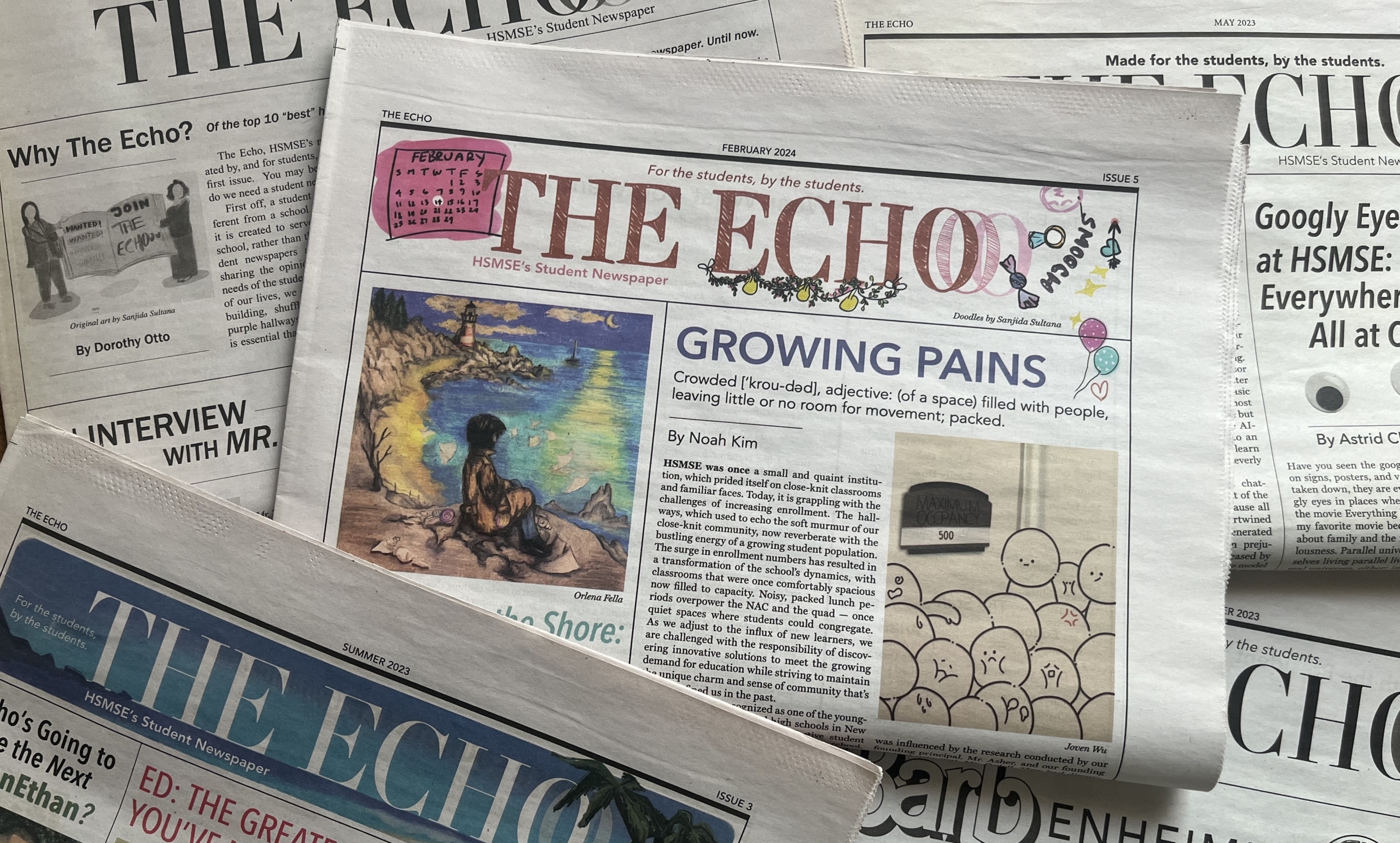Sign up for the daily CJR newsletter.
In 2022, on the day they met, Zoe Otto and Orlena Fella decided they wanted to start a newspaper at their school, Manhattan’s High School for Mathematics, Science, and Engineering.
They would call it The Echo, and they hoped it would build some community pride at their specialized STEM school—a place otherwise lacking that conventional Friday-night-football spirit. And they were sure about one thing: the paper had to be in print.
“I don’t think we ever considered it only being a website,” said Fella, who’s now a senior. “I just remember always thinking, It’s going to be a physical paper.”
Print may have largely vanished from the broader media landscape, but in high schools across the country, it’s alive and well. In 2020, 70 percent of school newspapers had a print edition, according to data collected by the Center for Scholastic Journalism at Kent State University. And in places where print editions have died, students are bringing them back: The Beacon, the student newspaper at Forest Hills High School in Queens, relaunched its print newspaper in 2022 after a ten-year hiatus; it likewise cited “a lack of school spirit” as its motivation.
Some of the resilience of paper in schools comes down to how student publications tend to be run—that is, by older faculty advisers who are more familiar with, if not stubbornly nostalgic for, print. But in recent years, print has gained a newfound pull among young people, whose experience with physical newspapers is likely limited to visits with their grandparents.
For students like Otto and Fella, a newspaper in print has a kind of throwback appeal, like a Polaroid camera. “Because it’s somehow new and retro, it’s interesting,” Fella said.
It also offers a respite from media overload.
“Really since the day I was born it was just like being surrounded by so much information, so much news, so many things that are going on,” Otto said. “Like, TikTok!” She buried her face in her hands, as if even the thought was too much. “It’s just crazy for your brain. To have a newspaper, especially one that’s in print—it’s a break.”
In The Echo’s first issue, Otto wrote a manifesto about the importance of student journalism in which she quoted a fellow student: “We are the rising generation. We are the ones who have to deal with all the crap that’s left behind.”
They’re also the ones who had to deal with the pandemic. Both students spent their freshman year entirely online. By the time they came to school in person, for sophomore year, they felt isolated. “The newspaper was a way to reignite some sense of community: this is what we own, this is who we are,” Otto said.
It took off. The paper’s staff soared from seven kids to forty-five, and it grew from a club into a full-time class, something both students believe wouldn’t have happened if they had launched a purely digital publication. “People were like, ‘I want to join something people are excited about,’” Otto said. “No one’s excited about a website.”
Kevin Kirms has witnessed this phenomenon firsthand. He runs the School Publications Company, a New Jersey printing house that has produced newspapers for high schools since 1926. After printing zero school papers in 2020, his numbers are now higher than pre-pandemic levels, and schools are opting for higher-quality paper and color editions. “A lot of the schools that went to digital newspapers are realizing that nobody’s reading them,” he said.
John Garrett, the owner of Community Impact Printing in Austin, has seen a similar uptick in requests to print student papers. “We have been slammed by high school journalism programs ditching digital only strategies and wanting us to print their newspaper this year,” he wrote in a LinkedIn post last month. As the head of a network of local print newspapers, Garrett isn’t surprised by this trend. While “most of our industry is so hell-bent on destroying their print product,” he told CJR, the community papers he prints have gone the other direction. Daily news lives on the website, but the flagship product is the newspaper itself, printed on thicker stock and distributed for free; ad revenues from local businesses have followed. “It isn’t what it was like pre-2000, but it’s good business, and people want it,” Garrett said.
Of course, high school papers are funded by obliging school budgets, not advertising revenues. But the idea that people are drawn to something that’s free, relevant to their community, and put right in front of them holds true. “Every issue, we all get together and take a stack of copies and pass them out,” Fella said. “Our launch day becomes this whole community event, and that’s really important and something that could never come out of a website.”
The Dispatch, a student newspaper in Austin, has had so much interest from contributors that editors have had to triage articles, with only the very best ending up in the physical edition. Students want their pieces to appear in print, said Mazzy Warren, one of the paper’s editors, “because they feel a sense of ‘It’s more real.’”
If the print product offers prestige for the young writer, it offers something else for the students they’re interviewing: a sense of privacy. Warren has had to deal with several takedown requests from students who agreed to be photographed or quoted for the school paper, but changed their mind when the article appeared online or on social media. “People have become really self-conscious about curating their own image,” Warren said. “They want to be able to control all of that. They don’t want to have their words or their image subject to other people, like journalists.”
Fella and Otto are torn about whether the boom in print publications among high schoolers means anything for the future of professional news.
But it might signal that the next generation of media consumers are oversaturated with digital content, and looking for something less ephemeral to hold on to.
“I think people really crave this, more than they even realize,” Otto said. “Maybe we’ve reached a point with phones that people are wanting something different.”
Has America ever needed a media defender more than now? Help us by joining CJR today.







